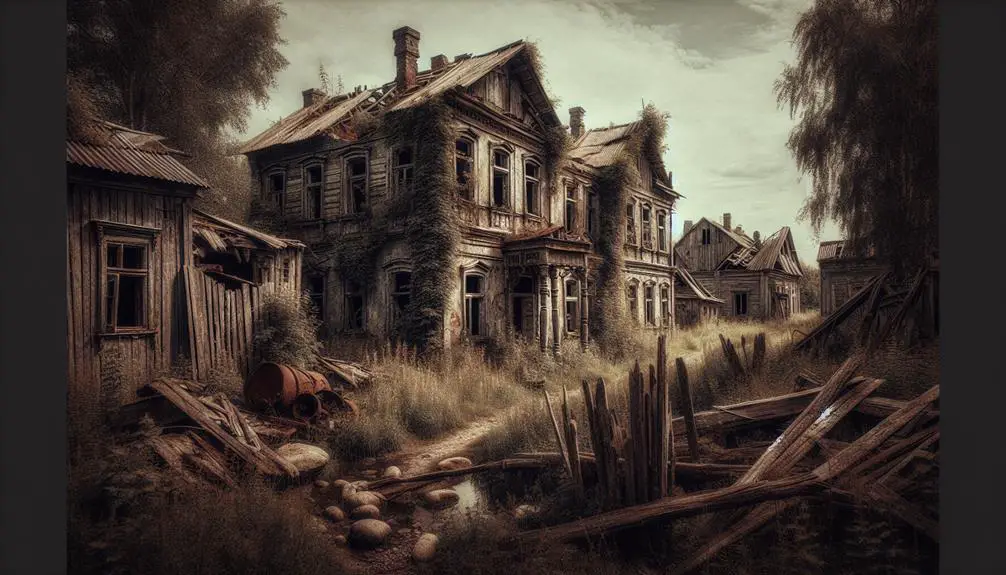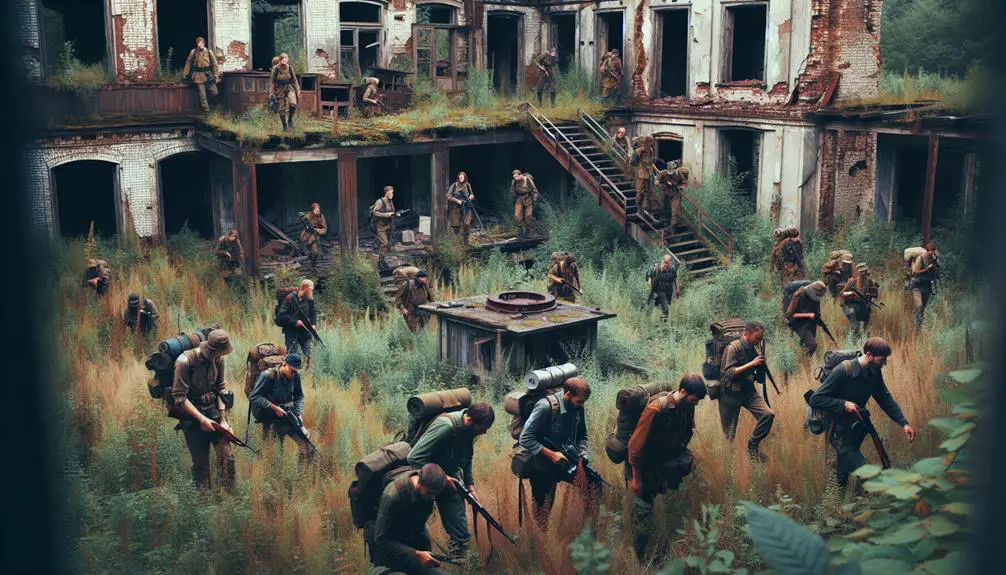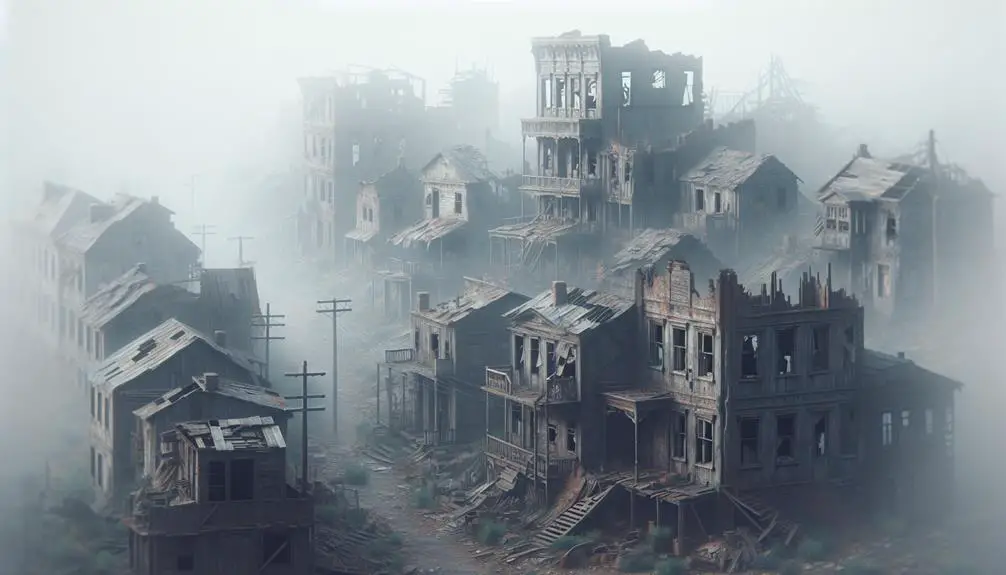When Civil War hit, resources shifted, stalling growth in settlements. Workers left, industries suffered, and jobs vanished. Battle scars left lasting psychological trauma. Communities stood strong but faced mental health challenges. Families were torn apart, neighborhoods emptied, and displacement left scars. Lack of upkeep led to infrastructure decay and dwindling resources. Cultural shifts weakened bonds and eroded identities. Understanding these factors reveals why ghost settlements stood abandoned. If you want to explore further, you'll uncover the full picture of their decline.
Key Points
- Civil War disruptions redirected resources from community development.
- Exodus of workers depleted local workforce, leading to economic stagnation.
- Psychological trauma and forced relocations fractured communities.
- Inadequate infrastructure and scarce resources hindered settlement sustainability.
- Cultural assimilation and societal changes weakened community identities and cohesion.
Economic Impact on Small Communities
Why did the Civil War lead to the economic decline and eventual abandonment of small communities? The answer lies in the significant impact the war had on job opportunities and community growth. During the Civil War, resources that would have otherwise been invested in developing small communities were redirected towards the war effort. This redirection resulted in a lack of economic support for these settlements, stunting their growth and prosperity.
As the war progressed, many men from these small communities left to join the military, further depleting the local workforce. This exodus of able-bodied workers meant that essential industries such as agriculture, manufacturing, and trade suffered, leading to a decline in economic activity. With fewer job opportunities available, residents found it increasingly difficult to sustain themselves and their families.
Without a robust economy to support them, small communities faced a bleak future. As the war drew to a close, many of these settlements were left economically devastated, prompting residents to seek opportunities elsewhere and ultimately leading to the abandonment of once-thriving towns and villages.
Effects of Battles on Settlements
The battles of the Civil War directly impacted settlements, leaving lasting effects on their infrastructure and population dynamics. The psychological trauma inflicted by the violence and loss experienced during battles lingered like a haunting presence in these small communities long after the conflicts ended. Many residents suffered from post-traumatic stress disorder and other mental health issues, affecting their ability to rebuild and move forward.
However, amidst the devastation, communities showed remarkable resilience efforts. Despite the challenges they faced, some settlements managed to come together, fostering community cohesion to support one another in the aftermath of the battles. This sense of unity helped them rebuild their homes, businesses, and lives. Through collective efforts and mutual support, these settlements slowly began to recover from the scars of war and create a new sense of normalcy.
The effects of battles on settlements were profound, shaping not only the physical landscape but also the emotional and social fabric of these communities.
Population Displacement and Migration
Population displacement and migration profoundly altered the demographics of Civil War-affected settlements, reshaping the social fabric and economic landscape. People were uprooted from their homes due to forced relocations, leading to a significant disruption in the established way of life. The historical context of the Civil War created a turbulent environment where families were torn apart, and communities fractured.
- Families torn apart, leaving behind shattered bonds of kinship and support.
- Communities fractured, with once vibrant neighborhoods turning into desolate landscapes.
- Forced relocations, stripping individuals of their sense of belonging and security.
- Historical context, highlighting the harsh realities faced by those caught in the midst of conflict.
These demographic shifts had long-term consequences, with the scars of population displacement and migration still visible in the empty ghost settlements that serve as a haunting reminder of the past. The effects of these events continue to echo through time, shaping the legacy of those who endured such hardships during the Civil War.
Changes in Infrastructure and Resources
Major transformations in infrastructure and resource allocation reshaped the spatial and material foundations of Civil War-affected settlements. The impact of the Civil War on these settlements led to a shift in development priorities, causing many areas to struggle with inadequate infrastructure and dwindling resources. As populations dwindled due to displacement and migration, the demand for basic amenities like water, food, and shelter changed significantly. This shift strained the existing infrastructure, which was often ill-equipped to handle the sudden changes.
The development of these ghost settlements was stunted as resources were scarce and largely diverted towards more immediate needs. Roads, bridges, and other critical infrastructure suffered from neglect, further isolating these communities. Without proper upkeep and investment, the once vibrant settlements deteriorated, leading to their eventual abandonment. The lack of resources and crumbling infrastructure created a cycle of decline that made it challenging for these areas to recover and thrive once again.
Societal Changes and Cultural Shifts
Amidst the aftermath of the Civil War, societal changes and cultural shifts influenced the trajectory of once-thriving settlements, contributing to their eventual abandonment. The evolution of societal values and cultural norms played a pivotal role in reshaping the fabric of these communities, leading to their decline. Here's how these changes impacted the ghost settlements:
- Erosion of Community Bonds: The tight-knit bonds that once held these settlements together began to unravel as societal priorities shifted, causing a sense of disconnection among residents.
- Shifting Economic Landscape: Changes in societal values towards industrialization and urbanization rendered the traditional economic activities of these settlements obsolete, forcing residents to seek livelihoods elsewhere.
- Cultural Assimilation: The influx of new cultural influences and norms post-Civil War led to a dilution of the unique identities of these settlements, eroding their cultural significance.
- Decline in Social Cohesion: As societal structures evolved, the once-strong social cohesion within these settlements weakened, leading to a breakdown in community support systems.
Frequently Asked Questions
What Role Did Superstition and Folklore Play in the Abandonment of Civil War Ghost Settlements?
Superstition and folklore played a significant role in the abandonment of Civil War ghost settlements. Beliefs in paranormal activity fueled fear, leading to deserted towns. Investigations into hauntings perpetuated the psychological impact, solidifying the ghostly reputation of these once-thriving communities.
Were There Any Documented Cases of Paranormal Activity in These Empty Settlements?
In some of these deserted Civil War settlements, there have been documented cases of paranormal activity. Through paranormal investigations, ghost sightings have been reported, adding to the mystery surrounding the empty ghost towns.
How Did the Lack of Access to Modern Amenities Contribute to the Decline of These Communities?
Without modern amenities, rural isolation contributed to community decline. Infrastructure limitations hindered growth, leading to a population shift. Inaccessibility to resources accelerated the emptying of Civil War ghost settlements, highlighting the impact of progress on small communities.
Were There Any Efforts to Preserve or Restore These Abandoned Civil War Ghost Settlements?
Efforts to preserve and restore abandoned Civil War ghost settlements vary. Preservation groups champion historical significance, while restoration projects aim to revive dilapidated structures. The resilience of these communities echoes through ongoing initiatives.
Did the Descendants of the Original Settlers of These Ghost Towns Play Any Role in Their Eventual Abandonment?
Descendants of original settlers in ghost towns often played a pivotal role in their abandonment. Community involvement waned as descendants moved away seeking new opportunities, leading to the eventual decline and emptiness of these settlements.



